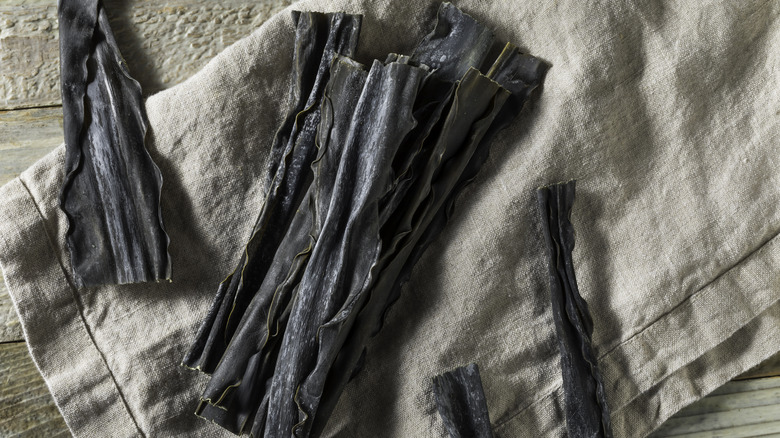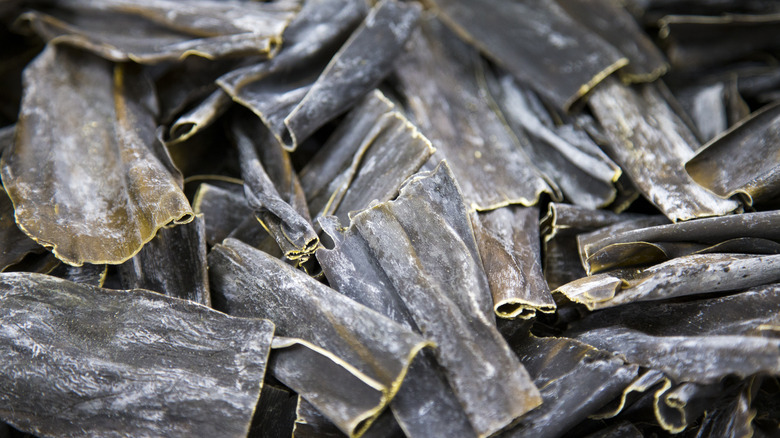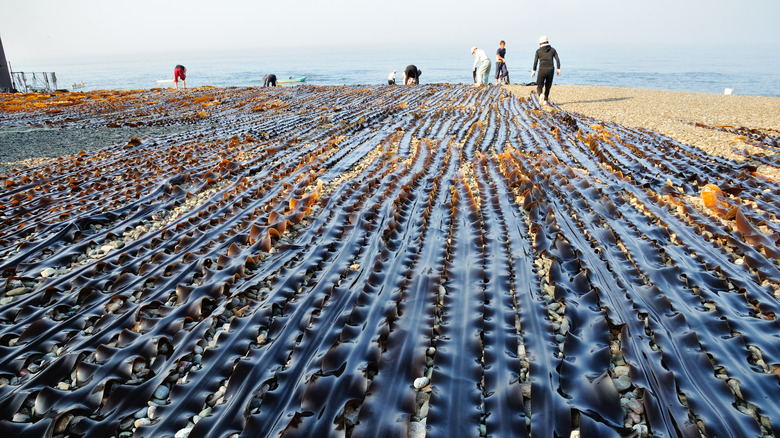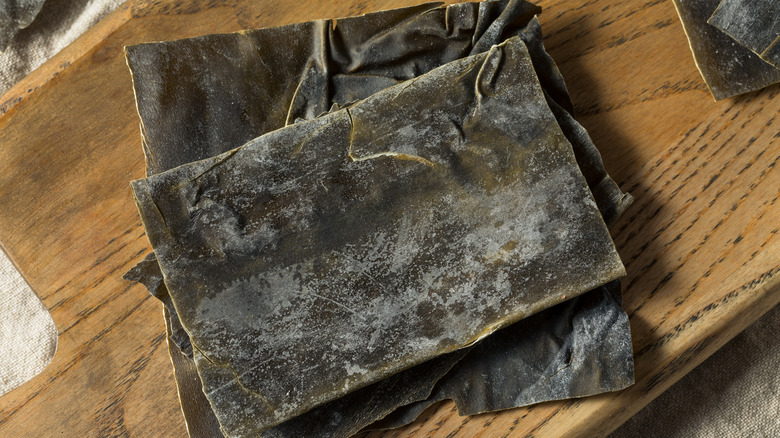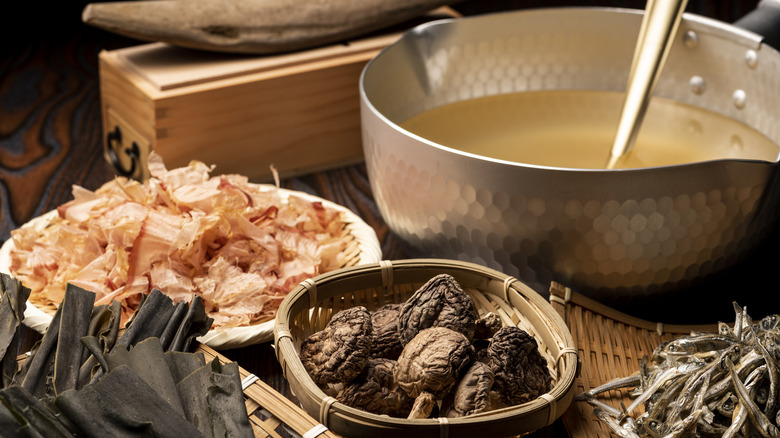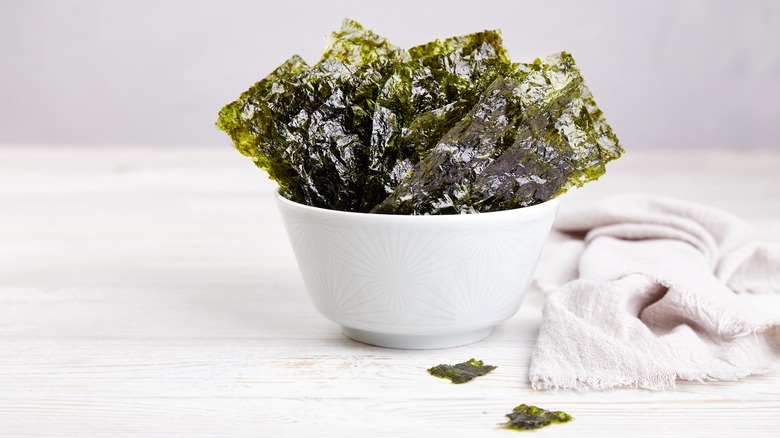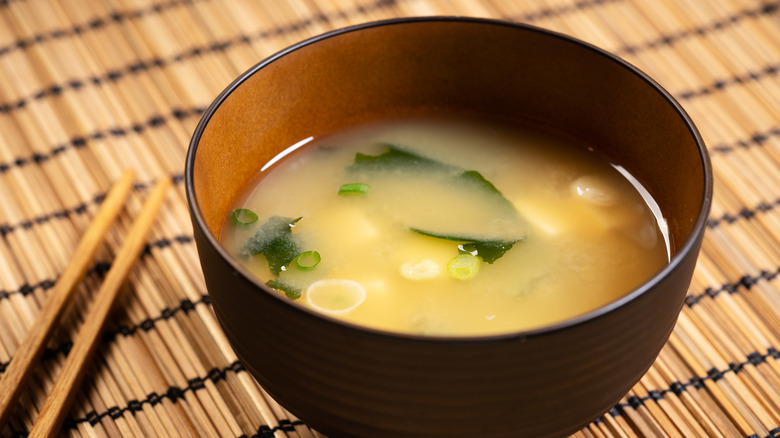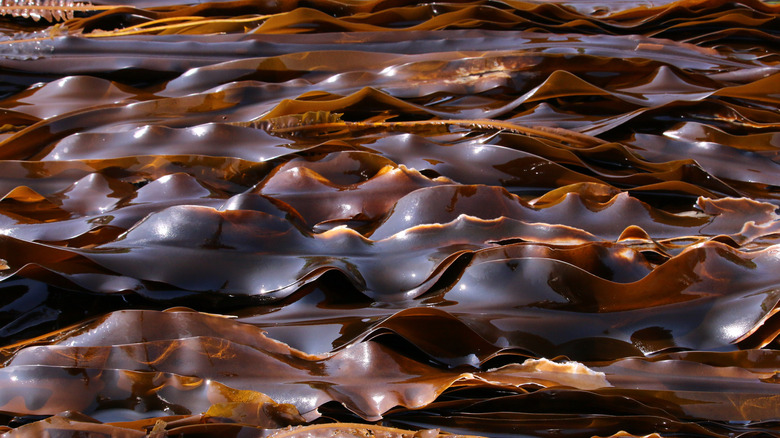Kombu Is The Seaweed Umami Staple You Should Have In Your Pantry
While we may be inclined to lump kombu into the same seaweed category as the ever-popular nori, kombu is actually a blanket term for a group of brown algae known as kelp (Phaeophyceae). Kombu has been used as a solid source of sodium, essential vitamins and minerals, and trace minerals spanning back millions of years. It was often served at special occasions and in temples as part of Buddhist cuisine because it is believed to symbolize happiness. Kombu is a staple in Okinawan cuisine and is found in most of their recipes. Okinawa represents one of the revered Blue Zones lauded for the health, longevity, and low rates of chronic disease found in its inhabitants.
You will almost always come across kombu in its dried and packaged form, but it's also sometimes available pickled or even fresh and living. Regardless of how and when you come across it, a package of the dried variety deserves a spot in your cabinet thanks to the umami-packed punch it offers the palate. As such, kombu is an excellent taste enhancer and seasoning for a multitude of culinary uses.
What is kombu?
Kombu is an edible type of sea vegetable from northern Japan that flourishes in the icy cold waters found there. It is a variant of kelp, specifically bull kelp. Kombu is rich in glutamate, an amino acid that makes up monosodium glutamate (MSG), which gives it that umami. The fifth flavor of umami was actually discovered thanks to a Japanese chemist conducting research on kombu and MSG.
A leaf of kombu has two layers that connect and can be opened to reveal a small pouch that can be used during cooking. The kombu you come across in stores and on menus will have been harvested in either its first or second year. First year kombu is much milder in flavor than its more mature counterpart. Second year kombu is the best option for making Japanese stock, known as dashi, due to its richer, deeper flavor. It's also more expensive for this reason. Kombu is a foundation of Japanese and other east Asian cuisines and as much of a staple there as chicken stock is in the West.
How is kombu made?
Kombu is easy to grow, but the process of getting it ready to eat is extensive. Wild kombu is found in the waters off northern Japan, but for commercial consumption, it is best produced on a much larger scale involving farming and machinery. Kombu seeds are sprouted in a nursery and then moved to the ocean to continue growing on hanging ropes. It takes about a year for the kombu to reach maturity and become ready for the next steps.
When of age, the leaves are removed from the rope and the processing begins, but the root stays intact in the ocean so new leaves can grow in the next cycle. For this reason kombu is a very sustainable crop. The raw kombu leaves are soaked in vinegar for preservation, laid out flat to dry, and pressed. The pressed leaves are then left to age until they are ready to be shaved into strips, packaged, and shipped to store shelves.
What does kombu taste like?
Coming from the sea, kombu naturally has a briny flavor but is not fishy in taste at all. It is ripe with umami and will add a punch of flavor to whatever dish it's mixed into. Many equate its taste to that of an earthy, vegetal yet meaty mushroom with a hint of sweetness.
Strips of dried kombu are often coated in a white powdery film. This is known as mannitol and is where much of the sea vegetable's sweetness lies, so it's best not to wash it off. Mannitol is a sugar alcohol chock-full of that elusive umami. A simple wipe down will suffice so as not to lose all of the richness in flavor.
The texture of kombu is usually described as tough and rubbery. It's not akin to nori in the sense that it makes a delicately crisp chip to snack on, however, it is brittle when you touch it. It does its best in a reconstituted (or soaked) form, such as in a broth like dashi.
How to cook with kombu
As mentioned, the most well-known culinary application of kombu is as a main ingredient in dashi, a stock that is the basis of many Japanese dishes and the broth used in the popular shabu-shabu hot pot. It consists of kombu, dried bonito flakes (made from skipjack tuna), and shiitake mushrooms. Dashi is used in miso soup, tofu soup, noodle bowls, and many other classic dishes. Kombu is also used to make a vegetarian broth sans the bonito flakes.
Reconstituted kombu is often cut into strips and added to seaweed and other salads. It is also used to flavor sushi rice and pickles, to cure meats and vegetables, and added to braises for extra flavor, such as for short ribs or brisket. It is sometimes crumbled or ground into a powder from its dried form and used as a salt substitute with an added hit of umami. The powder or crumbles can be mixed with butter to form a complex spread with savory notes.
Kombu vs. nori
Side-by-side, kombu is thicker and less fragile than nori. This is because nori is a red algae and kombu is a type of brown algae kelp. Kelp grows larger and in more hazardous conditions than nori, hence its hardier structure. Flavor-wise, kombu is bolder than nori; nutritionally, it offers a more robust source of iodine than nori, according to Vegan Foundry. Unlike nori and its many chip varieties, kombu is rarely eaten on its own. Kombu is used to add flavor and umami to dishes whereas nori is used to wrap sushi and enjoyed as a snack with minimal seasoning.
While the two differ greatly in taste and texture, there are a few instances when it's acceptable to make a swap. This is generally a one-way street, meaning nori can sometimes take the role of kombu but kombu will most likely fail as a nori stand-in. A clear example of this is sushi — you cannot make a hand roll out of kombu. On the other hand, nori will work as a sub-in for instances where kombu is being used as a small addition but not the main event. You can, for example, tear up a sheet of nori and add it to a miso soup, but due to its weaker flavor and fragile status in liquids, nori won't work to make dashi or a stock.
Where to buy kombu
Dried kombu is regularly stocked at Japanese and Korean grocers, and also widely available at health food stores and major grocery chains such as Whole Foods in the Asian cooking aisle. It can be found next to the ever-popular nori sheets used for at-home sushi makers. Dried kombu is also easy to find online. It's best stored in a dark and dry spot in the kitchen as moisture and light may induce mold growth. Kept in an airtight container to preserve freshness, it will be good for about a year.
Its pickled form may be a bit harder to come across but recipes to make your own variations are plentiful online. You will most likely never come across fresh kombu in stores, but it can be purchased directly from producers, such as Monterey Bay Seaweeds, and is overnighted, essentially arriving at your door fresh out of the ocean. When refrigerated, fresh kombu will keep for about a week.
Nutritional information of kombu
A ¼ cup of kombu contains just 17 calories, 0 grams of fat, and 3 grams of carbohydrates; it also has 1 gram of both protein and fiber, per Very Well Fit. While not a significant source of macronutrients, it does offer up a bunch of micronutrients. Remember too that Kombu is a rich source of iodine, which is a precursor to important thyroid hormone production, per UMass Chan Medical School. It also contains iron, calcium, vitamins A and C, and other trace minerals.
In addition to kombu's many culinary uses, it offers up the ability to help us digest beans. Kombu contains an enzyme known as glutamic acid that helps us break down the sugars in beans that often cause gas. Consider adding a bit of this kelp to any legume dish in order to aid in digestion and reduce bloating while also seasoning up the meal.
Types of kombu
There are 35 different types of kombu found all over the world, 14 of which are grown in northern Japan. Of those 14, four types are the most widely available and what you have probably come across in stores and cuisine. These are: karafuto kombu, ma kombu, mitsuishi kombu, and rishiri kombu.
Karafuto kombu is on the sweeter side because of its high concentrations of mannitol. Ma kombu is the most popular variety; this type is thick and wide, light brown in color, and will create a clear broth when simmered. It is used for clear soup and hot pots. Mitsuishi kombu is what is most often used to make dashi stock and is sometimes referred to as dashi-kombu for this reason. Rishiri kombu has a strong and salty flavor, deep brown color, and will yield a darker broth. It is named after Rishiri Island where it is found near Hokkaido.
